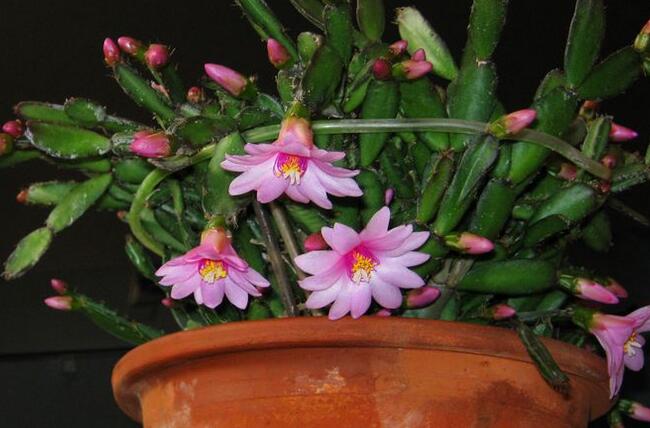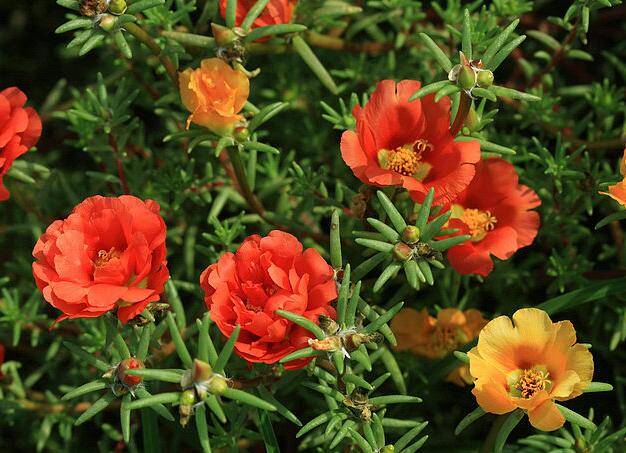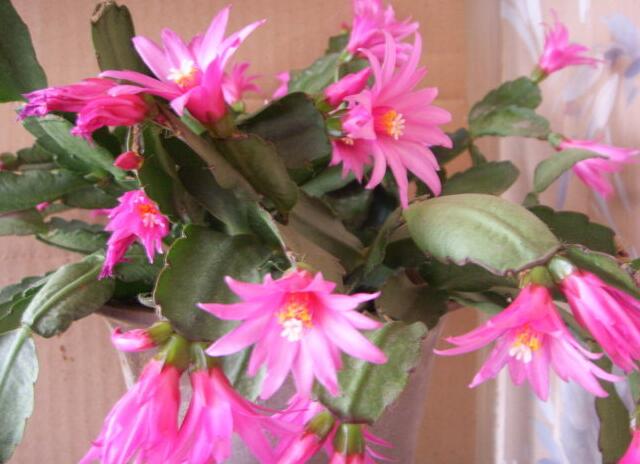The cultivation method of falling Flower Dance teaches novice flower friends how to raise it.
The dance of falling flowers is native to southern Brazil and is epiphytic on the trunks and branches of the subtropical jungle. It likes a warm, humid semi-shaded environment, shading and ventilation in summer, and keeping room temperature above 10 ℃ in winter with plenty of light. How to raise the dance of falling flowers? The following editor brings you the breeding method of falling Flower Dance.

How to raise the dance of falling flowers:
Dance of falling flowers, like warm, moist and semi-overcast environment. Not cold-resistant, resistant to semi-shade, afraid of waterlogging, suitable for pot or basket cultivation. The suitable temperature for the growth of falling flower dance is 18-23 degrees Celsius, the suitable temperature for flowering is 10-15 degrees Celsius, and the winter temperature is not less than 12 degrees Celsius. The soil should be rich, loose and well-drained sandy soil, but there should be no calcareous composition in the flower soil. The dance of falling flowers can be cultivated indoors all the year round, and pay attention to avoid direct sunlight. Keep the temperature and light from January, but when the first bud appears, it should be moved to a warmer environment and watered more. To ensure that the flowers bloom more and more beautifully.
The dance of falling flowers is native to southern Brazil and is epiphytic on the trunks and branches of the subtropical jungle. It likes a warm, humid semi-shaded environment, shading and ventilation in summer, and keeping room temperature above 10 ℃ in winter with plenty of light.
Like warm and humid semi-overcast environment, there are requirements for a certain degree of air humidity, summer should be well ventilated, and avoid hot sun exposure. It is suitable for growing in soil which is rich in humus, loose and fertile, and has good drainage and air permeability.
Maintenance skills of falling Flower Dance:
Change the basin: change the basin every two years. When changing the basin, cut the branches that are too long or too dense. The basin usually chooses 12-15 cm basin, and the hanging basket chooses 15-20 cm basin, with 3 plants per basin.
Watering: water once a week in spring and autumn to keep the soil moist. It should be properly shaded in summer and keep the soil moist moderately in winter. The specific watering times depend on the room temperature highland.
Fertilization: fertilize once a month, choose low nitrogen fertilizer or succulent special fertilizer.
Lighting: ensure sufficient light during flowering and move as little as possible so as not to break the stem and fall flowers.
Diseases and insect pests: common diseases and insect pests are anthrax, red spiders, once diseased plants are found to remove diseased leaves in time, spray fungicides.
The culture methods and matters needing attention of crab claw orchid teach you how to raise crab claw orchid
Crab claw orchid, also known as crab claw lotus, is one of the potted plants loved by many people. So what are the breeding methods and matters needing attention of crab claw orchid? The following wed114 wedding network will teach you how to raise crab claw orchids correctly.
The culture methods and matters needing attention of crab claw orchid teach you how to raise crab claw orchid
The culture method of crab claw orchid:
First, the soil for growing flowers should go first.
In the cultivation method of crab claw orchid, the choice of soil is very important, especially for novice flower friends, a good soil is very important to whether the flowers can be raised well. The cultivation of crab claw orchid can use a relatively fertile mixed soil of rotten leaf soil, peat and coarse sand, and the pH should be kept between pH5.5-6.5. in the cultivation of crab claw orchid, the choice of soil is very important, especially for beginners.
II. Conservation of the environment
The culture environment of crab claw orchid requires semi-overcast and humid, avoid hot sun and rain in summer, and warm and sufficient light in winter. The suitable temperature for the growing period is 18: 23 ℃, the suitable flowering temperature is 10: 15 ℃, no more than 25 ℃, and the best temperature is 15 ℃, and the winter temperature is not lower than 10 ℃. Crab claw orchid is a short-day plant, so it can bud and blossom under short-day conditions.
The culture methods and matters needing attention of crab claw orchid teach you how to raise crab claw orchid
Third, how to water
Watering has always been a continuous topic, there are always flower friends do not master it well, crab claw orchid is not so easy to die when there is lack of water, but it is very easy to die when there is stagnant water, so flower friends must water crab claw orchid rather than flood it, do not work hard to flood, keep watering.
IV. Propagation of crab claw orchid
Crab claw orchid reproduction of the most common method is to insert forward, the method is very simple, is to take a few pieces of paper can be inserted forward, the survival rate is very high.
The culture methods and matters needing attention of crab claw orchid teach you how to raise crab claw orchid
5. Management of flowering period of crab claw orchid
Crab claw orchid florescence is a little hypocritical, to control water and stop fertilizer, crab claw orchid is particularly sensitive to water, water is easy to drop buds, serious rootstocks will rot roots, resulting in plant death; lack of water is easy to wilt flowers, buds can not mature. The correct method is: keep the basin soil in a slightly wet state, it is appropriate to pinch it by hand, and spray with the same water as the indoor temperature at noon every day, so that you can get twice the result with half the effort. If the basin soil is too dry, it can not be watered at once, but can be watered step by step. Too much watering at one time will make the plant drop buds and stems.
The culture methods and matters needing attention of crab claw orchid teach you how to raise crab claw orchid
Notes on Crab claw Orchid:
1, do not often move the position, find a suitable environment, always there, especially in the bud stage, can not casually move the position of the flowerpot, it is easy to cause falling buds.
2. Although crab claw orchid likes semi-shady environment, it needs short sunshine if it wants to blossom.
How to raise winter coral, the methods and precautions of winter coral culture / not afraid of bright light
As a beautiful indoor potted plant, winter coral flower friends should be no stranger, it has fruit all the year round, so it is also known as the four seasons fruit. In life, many people will choose to raise a pot of winter coral at home, then how to raise winter coral? In this regard, the editor carefully sorted out the winter coral culture methods and matters needing attention, very comprehensive, friends who want to raise must have a look.
First, how to raise winter corals and understand their habits
Winter coral likes sunshine and warm environment, and it is resistant to high temperature, no sunburn above 35 ℃, but also resistant to direct light, even in the summer sun. Therefore, when breeding indoors, it should be placed in a bright place, and warm measures should be taken in winter. So how to raise winter coral, it is very simple, to meet its growth habits, specific requirements for us to move on.
II. Culture methods and matters needing attention of winter coral
1. Basin soil requirements
How to cultivate potted winter coral, the first thing is to choose potted soil. Although to the florist to buy winter coral, there are existing pots and soil, but in order to raise it well, it is necessary to re-choose flowerpots and soil.
Flowerpot: just get a beautiful one, but pay attention to the right size. Soil: although winter coral does not require much of the soil, it is best to choose slightly acidic or neutral soil that is fertile, loose and well drained. When applying soil, you can add a little base fertilizer to the soil.
2. Lighting
In the cultivation of winter coral, light is indispensable. Winter coral likes light and is not afraid of strong light, so it can also be placed outside in the summer sun.
Note: winter corals need plenty of light to grow, direct light for at least 4 hours a day, and no shade, preferably in front of a bright southeast window or balcony.
3. Temperature
In the growth process of winter coral, the temperature also needs to be regulated accordingly. Winter coral likes to be warm and resistant to high temperature, and the most suitable growth temperature is between 18 and 25 ℃, so if you want it to grow well, it is best to maintain this temperature.
Note: winter corals are not cold-resistant and should be kept indoors when the temperature is low in winter. And the ambient temperature should not be lower than 5 ℃, otherwise it will be frostbitten and cannot survive the winter safely.
4. Watering
How to raise winter coral, watering is indispensable. It is understood that winter coral is not resistant to drought, but it is afraid of waterlogging, so there is stagnant water in the basin. In indoor breeding, we should appropriate amount of watering, keep the basin soil moist, should not be too dry or too wet.
Note: when winter coral blossoms, we should pay attention to control watering, so as to avoid falling flowers and fruits. When the fruit grows to the size of mung beans, it can be watered normally.
5. Fertilization
After watering, let's talk about fertilization, which is also very important in the culture of winter coral. Winter coral likes fertilizer, and flower friends can apply thin liquid fertilizer to it every half a month.
Note: before the winter coral blossoms, it should be given some phosphate fertilizer, which can make the winter coral flowers more fruitful.
6. Diseases and insect pests
In the process of breeding, beginners often encounter some problems, such as when the temperature is high, the plant suffers from anthracnose, harms the stems and leaves, and the disease is more serious. In addition, winter corals can be found by aphids because of improper maintenance. All these will seriously affect the ornamental nature of winter coral, so when diseases and insect pests are found, they should be controlled immediately. In this regard, you can refer to the pest control of winter coral.
Generally speaking, winter coral is quite easy to raise, but if you want to have a lot of flowers and fruits, you need to pay more attention to water and fertilizer, so that winter coral can produce beautiful flowers. On the method of winter coral culture, the editor introduced here, the flower friends might as well raise and see, and finally wish everyone's winter coral can bloom beautiful flowers.
- Prev

What should be paid attention to in the planting method of Scutellaria barbata
Scutellaria barbata is a good beautification and decoration of flowers, its bright and moving colors and beautiful and skilled flowers, used to decorate the bedroom and courtyard is a very good choice. Today, the editor brings you the planting methods and points for attention of Scutellaria barbata. Let's take a look at the details.
- Next

The production method of falling Flower Dance Bonsai sharing by ordinary hanging method
The dance of falling flowers has not been introduced into our country for a long time, with gorgeous colors and many flowers, which is suitable for hanging decoration and common ornamental effect, so it is worth recommending to flower friends. Let's make a falling flower dance dancing in the wind. Today, what the editor brings to you is the method of making bonsai dance of falling flowers. Let's take a look at the details.
Related
- Fuxing push coffee new agricultural production and marketing class: lack of small-scale processing plants
- Jujube rice field leisure farm deep ploughing Yilan for five years to create a space for organic food and play
- Nongyu Farm-A trial of organic papaya for brave women with advanced technology
- Four points for attention in the prevention and control of diseases and insect pests of edible fungi
- How to add nutrient solution to Edible Fungi
- Is there any good way to control edible fungus mites?
- Open Inoculation Technology of Edible Fungi
- Is there any clever way to use fertilizer for edible fungus in winter?
- What agents are used to kill the pathogens of edible fungi in the mushroom shed?
- Rapid drying of Edible Fungi

